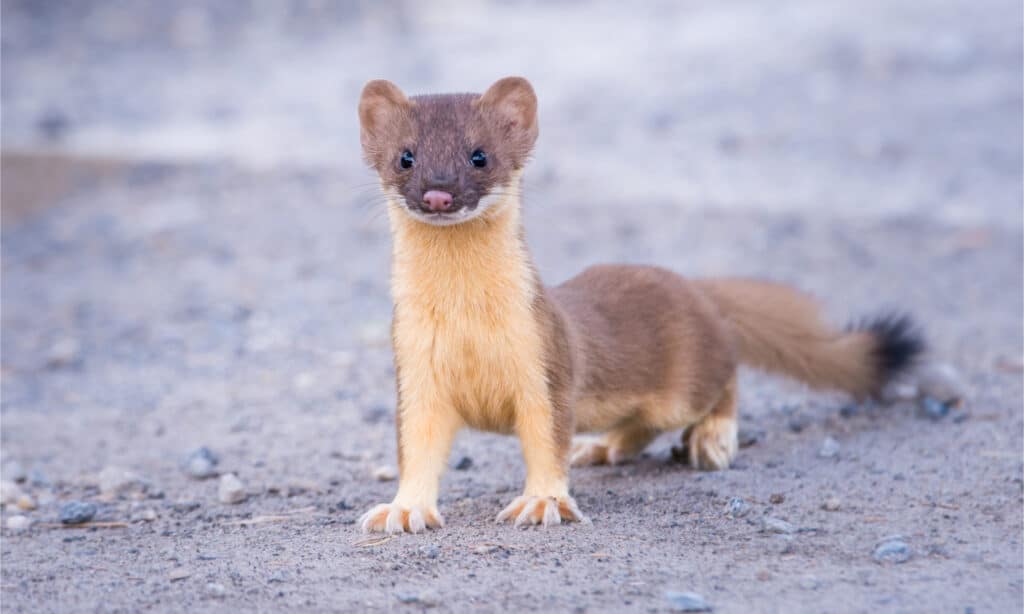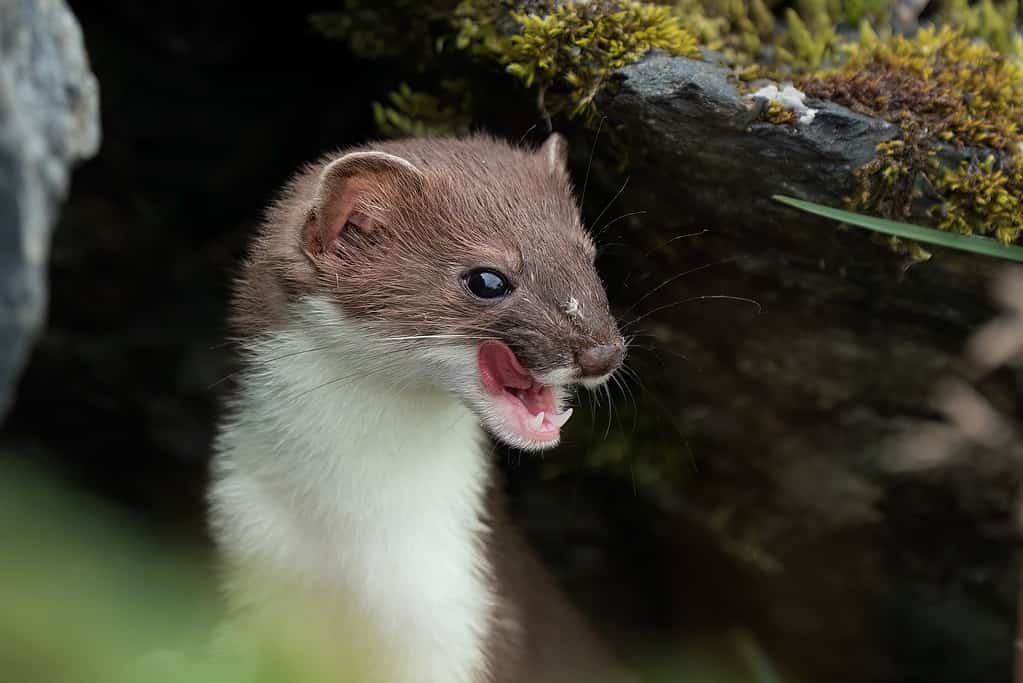Weasel teeth may not be the first thing that comes to mind when thinking about these sleek and agile predators, but their teeth are actually quite impressive! Weasels are a diverse group of mammals belonging to the family Mustelidae, which contains approximately 60 species of animals such as ferrets, otters, minks, and badgers. There are 16 extant species of weasels, three of which [long-tailed weasel (Mustela frenata), short-tailed weasel (Mustela erminea), and least weasel (Mustela nivalis)] call North America home.
Weasels are small, generally weighing less than one pound (0.45 kg). Despite their small size, weasels are known for their sharp teeth, which are essential for hunting and eating their prey. Adult weasels have 34 teeth, including incisors for biting, sharp canines for grasping, and also premolars and molars for crushing and grinding. But what makes weasel teeth so special? Open up and say ahhhhh! Let’s take a closer look!

Weasels are small in size, generally weighing less than one pound (0.45 kg).
©Ghost Bear/Shutterstock.com
What Kind of Teeth Do Weasels Have?
Weasel teeth are made of dentin covered with enamel. Dentin is the hard, dense tissue that forms the bulk of the tooth structure. It is a living tissue that is found underneath the enamel, the outermost layer of the tooth. Dentin is composed of tiny channels called dentinal tubules, which contain fluid and are made up of a combination of organic material, such as collagen, and inorganic material, such as calcium and phosphorus.
Dentin is an important part of the tooth structure because it helps support the enamel and protect the sensitive pulp (the innermost part of the tooth that contains nerves and blood vessels) from external stimuli. Weasel teeth are adapted for their carnivorous diet, with sharp, pointed teeth for biting and tearing flesh.
Weasel Milk Teeth
Baby weasels, called kits, are born without teeth. Their first set of teeth, known as deciduous or milk teeth, begin to emerge when they are approximately 2-4 weeks old. Weasels have a total of 28 deciduous teeth which are divided into four types:
- Incisors: Baby weasels have 12 incisors, which are located at the front of the mouth. Six are in the upper jaw, and six are in the lower jaw. These teeth are used for biting and cutting food.
- Canines: Weasel kits have four canines, which are long, pointed teeth located next to the incisors. These teeth are used for grasping and tearing food. One pair upper and one pair lower.
- Premolars: These mammals have eight premolars, which are located between the canines and molars. These teeth are used for grinding and crushing food. There are two pairs, upper and lower.
- Molars: Weasel young have four molars, which are located at the back of the mouth. These teeth are also used for grinding and crushing food. One pair each, upper and lower.
These milk teeth are soon replaced by a set of adult teeth, which begin to emerge when the weasel is between 6-12 weeks of age. The permanent teeth are larger and stronger than the milk teeth, and they will stay with the weasel for the rest of its life.
Weasel Permanent Teeth
The number of teeth will vary among species and among individuals within a species. On average, however, adult weasels have 34 permanent teeth including incisors, canines, premolars, and molars. Their teeth are well-suited for hunting small rodents and other prey. The permanent teeth of weasels are apportioned thusly:
Incisors
Most weasels have 12 incisors. Their incisors are distributed evenly in the jaws, with six in the upper jaw and six in the lower jaw. Incisors are teeth that are specialized for cutting and biting. They are located at the front of the mouth and are typically flat and thin with a sharp edge.
In weasels, incisors are used primarily for capturing prey. Weasels are carnivorous and feed primarily on small animals such as rodents, rabbits, and birds. Their sharp incisors allow them to bite through the skin and fur of their prey. Incisors are also important for other functions, such as grooming and defense. In some species, incisors may be used for digging or cracking open hard shells.
Canines
Weasels have four canines in total, with two located in the upper jaw and two in the lower jaw. The canines are the long, pointed teeth located next to the incisors in the front of the mouth.
The primary function of the canines is to grasp and hold prey. Weasels are carnivorous animals that hunt and feed on small animals such as rodents, rabbits, and birds. Their canines are specially adapted for piercing the flesh of their prey and holding onto it while the weasel delivers a killing bite.
In addition to their primary function in hunting, the canines of weasels are also important for defense. Weasels are small animals that are vulnerable to predators, and their sharp canines can be used for defense.

The canines are the long, pointed teeth located next to the incisors in the front of the mouth.
©Cavan-Images/Shutterstock.com
Premolars
Most weasels have a total of 12 premolars, six in the upper jaw and six in the lower jaw. Premolars are the teeth located between the canines and molars. They are used for crushing, grinding, and shearing food. The specific number and arrangement of premolars will vary between species of weasels, but in general, the upper jaw has two pairs of premolars, and an additional pair of teeth called the sectorial or carnassial teeth. The lower jaw has three pairs of premolars. The premolars in weasels are not as specialized as the carnassial teeth, but they still play an important role in the weasel’s dental structure and are used in combination with the other teeth to effectively capture, kill, and consume prey.
Molars
Most weasels have one molar on each side of the upper jaw and two molars on each side of the lower jaw, for a total of six molars. The molars are located in the back of the mouth, behind the premolars and canines, and are used for crushing and grinding food. In the lower jaw, the first pair of molars are carnassial teeth.
Carnassial Teeth
The carnassial teeth are the last upper premolar and the lower first molar in weasels. Carnassial teeth are sharp and function as specialized shearing teeth. These teeth are modified with the upper premolar having a large, blade-like shape and the lower first molar having a corresponding basin-like shape to create a scissor-like action. The carnassial teeth in weasels are a key adaptation that enables them to efficiently slice through the flesh which is important for their carnivorous diet. Weasels are active predators that feed primarily on small mammals and their carnassial teeth are essential for efficiently breaking down and consuming their prey.
How Do Weasels Use Their Teeth?
Weasels use their teeth for hunting and feeding. Their sharp teeth are specialized for grabbing and biting prey, and they have a strong bite force relative to their size. Weasels are carnivorous animals and their diet consists principally of small mammals, such as mice, rats, and rabbits. They use their teeth to bite the neck or head of their prey to quickly dispatch it. They have a set of long, sharp canine teeth that they use to puncture and grip the prey, and they also have molars at the back of their jaw for grinding up flesh and bones. Their teeth are also useful for defense against predators or fighting off competitors.
Weasel Bite Force
The bite force of a weasel is not as well-studied as larger animals like tigers, but it is estimated to be around 200-600 pounds per square inch (psi) depending on the species. This is relatively strong for an animal of its size and allows weasels to deliver a quick and deadly bite to their prey. When accounting for their tiny size, weasels actually have a stronger bite force than tigers or bears!
The photo featured at the top of this post is © Cavan-Images/Shutterstock.com
FAQs (Frequently Asked Questions)
What do weasels eat?
Weasels are carnivores, which means they eat meat.
The diet of weasels can vary depending on their species and location, but their main prey includes small mammals like rodents, rabbits, and birds. They are also known to eat insects, reptiles, amphibians, and fish.
Weasels are skilled hunters and are capable of taking down prey that is much larger than they are. They have sharp teeth and strong jaws that allow them to kill their prey quickly and efficiently.
Where do weasels live?
Weasels are found in various habitats around the world, including forests, grasslands, wetlands, and tundra. The specific location and habitat that weasels inhabit depend on their species and geographical location.
There are several different species of weasels, and each has a different range and habitat. For example, the least weasel (Mustela nivalis) is found in North America, Europe, and Asia and lives in a variety of habitats, including open fields, forests, and wetlands.
The ermine (Mustela erminea), also known as the stoat, is found in North America, Europe, and Asia and can be found in a range of habitats, including forests, grasslands, and tundra.
Do people hunt weasels?
Weasels are not commonly hunted by humans for their meat, but they may be trapped or hunted for their pelts. Weasels have soft, thick fur that is highly prized in the fur trade.
In some regions, weasels may be seen as pests because they cause damage to poultry and other small livestock. In these cases, weasels may be trapped or killed to protect the farmer’s investments.
Are weasels an endangered species?
There are many different species of weasels. Some species of weasels are considered to be of least concern by the International Union for Conservation of Nature (IUCN), meaning that they are not currently at risk of extinction. Other species, however, like the Colombian weasel (Mustela felipei) are listed as vulnerable.
Do weasels make good pets?
Weasels are not typically kept as pets because they are wild animals and have specific needs and behaviors that are difficult to meet in a domestic setting. Weasels are also active and curious animals that require a lot of space and mental stimulation, and they can be difficult to train and handle.
Thank you for reading! Have some feedback for us? Contact the AZ Animals editorial team.






